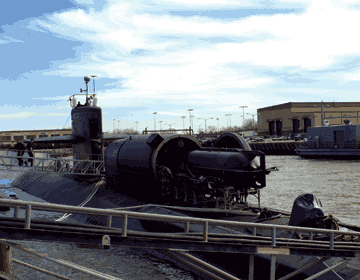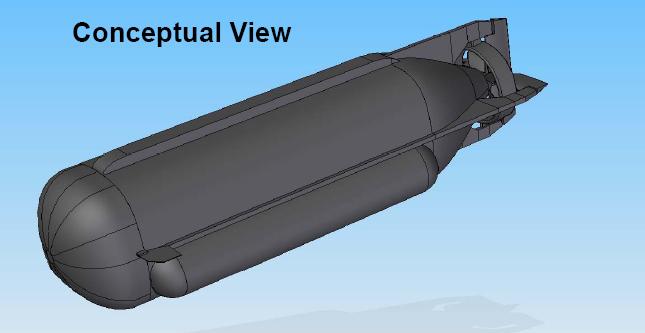Original URL: https://www.theregister.com/2009/04/10/minisub_data_bus_specs/
New Navy SEAL minisub's IT-system specs released
US frogmen to get inertial nav, 'plug & play' periscope
Posted in Science, 10th April 2009 17:16 GMT
The secretive US Special Operations Command (SOCOM) has revealed the data-handling features it would like to see on its planned new fleet of mini submarines for use by elite US Navy frogman-commandos.
At the moment, the famous yet hush-hush Navy SEALs use the Swimmer Delivery Vehicle (SDV) Mark 8 Mod 1, a large electrically-propelled torpedo-like craft which typically operates from a "dry deck shelter" fitted to a full-size US nuclear submarine. The cylindrical deck shelter is hooked up to the sub's aft escape hatch, functioning as an underwater docking bay for the mini-sub. Four SEAL passengers and two crew can ride in the SDV, wearing breathing apparatus. Once the sub mothership has got as close to the objective as it can, the dock floods and the SDV is launched. After a mission, it returns to the docking bay assisted by divers from the mother sub.

What the black-neoprene-clad killer frogman rides to work
The Mark 8 Mod 1 "Eight Boat" is said nowadays to be the only minisub remaining in service with the SEALs. There was formerly a Mark 9, which carried a brace of torpedoes instead of passengers (these would have been intended more for attacking ships in harbours or anchorages than for James Bond style minisub-v-minisub dogfights). However, the Mark 9 was apparently retired in the 1990s. The sole, ill-fated prototype Advanced SEAL Delivery System (ASDS) minisub - which would have allowed frogmen to travel in the dry, without requiring them to wear diving sets - was recently put out of action in a fire.
But the 1970s-era Mark 8s, even with their 1990s Mod 1 life-extension package, are getting a bit past it according to SOCOM. In particular, their data bus is so old that upgrading it with new information systems is all but impossible:
The MK 8 MOD 1 SEAL Delivery Vehicle (SDV) is approaching the end of its service life. The system was originally designed around a standard 1553 data bus, making upgrades and replacements no longer cost effective due to obsolescence. In some cases, increased capability may be available but the lack of an open architecture prevents cost effective upgrade of the systems.
Plug-n-play periscope, automatic docking, sonar detectors: It's not your father's mini-sub
The SDVs were to have been replaced by the ASDS, which would have mated directly to the mother sub without need for an attached docking bay. But in the event the ASDS, despite massive delays and cost overruns, always tended to get badly damaged if the carrying sub went at all fast. It was severely criticised by US government auditors even before it caught fire, and the programme now appears to be quite literally dead in the water.
Thus SOCOM have decided on a less ambitious replacement craft which they call Shallow Water Combat Submersible (SWCS), essentially a modernised SDV. The SWCS has been discussed now and again for several years now.

And here's the new version. Now with open-architecture data handling.
So far, so what. But now, in a request for information issued last month, SOCOM have said they'd like to hear from someone who can make them an "Integrated Bridge System" for their new mini-sub (that's essentially a new comms/sensors/IT chassis, not a folding gangplank or something):
The SWCS will require development of an IBS with an open architecture, a power and signal distribution system capable of integrating various electronic systems and sensors, and the capability to display operational data to the vehicle pilot and navigator.The IBS must address ... the growing ability of hostile nations to detect, identify and target [special-ops frogmen] conducting undersea tasks. Thus, the SWCS shall have a modular subsystem design conducive to accommodating upgrades to processors and sensors. Operating in a free-flooding "wet" vehicle, the SWCS passengers and crew transit for extended durations (up to 12 hours) in a wet, variant temperature environment while breathing from SCUBA gear. Thus hardware and software selected must feature interfaces that ensure required operator actions are simple and minimized.
The SOCOM planners give a list of things they want the new frogman-carrier's data handling system to do, giving some interesting insights. They'd like the minisub pilot to know if he was being scanned by hostile sonar, for instance, or (if on the surface) by radar: the IBS should offer the option of plugging in "passive sonar, and ESM [Electronic Support Measures - radar detectors, to you and me]."
The current SDVs navigate underwater using seabed-scanning doppler sonar, as satnav signals can't be used when submerged. Unfortunately, a sophisticated enemy can use the sonic pulses emitted by the Mark 8's nav sonar to detect it. SOCOM would prefer the future SWCS to feature inertial navigation.
Apart from this, the new mini-sub should if possible feature wireless through-water comms of the sort now used by civilian divers, and must have a soundless, secure option using wires too. The ability to download mission data wirelessly when docked aboard the mother ship is desirable, but a hardwired umbilical mode is also fine.
It would also be nice if the SWCS' on-board computers and controls were clever enough to bring it in for automated docking without help from divers. This would put slightly less strain on accommodation aboard the mother sub. There are some specially-converted former ICBM vessels specially intended to carry a force of SEALs, but where the dry deck module is fitted to an ordinary attack boat the SEALs and docking-bay divers have to "hot bunk" - take turns sleeping - with the submarine crew.
Finally, the info request reveals that the SWCS will feature an extend-able "sensor mast ... allowing the Plug-n-Play integration of various imaging sensors" (periscopes are so last century) and the IBS data system should obviously allow for recording these images and displaying them to the minisub's crew.
All the cunning minisub electronics needs to work at depths of at least 190 feet, ideally as much as 300 feet, and it should be 95 per cent reliable over 15 twelve-hour missions.
Full details here, for anyone interested. British readers may care to note that Her Majesty's equivalent of the US Navy SEALs - the Special Boat Service (SBS, the maritime SAS) - also currently use the Mark 8 Mod 1 SDV and will probably follow the SEALs onto SWCS in due course. ®